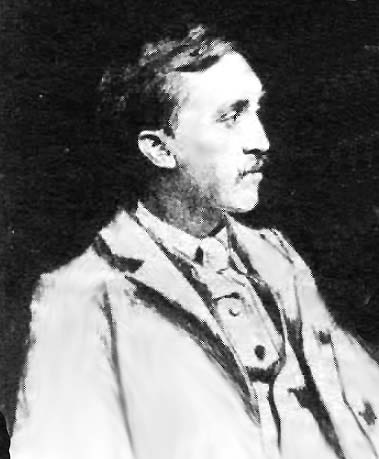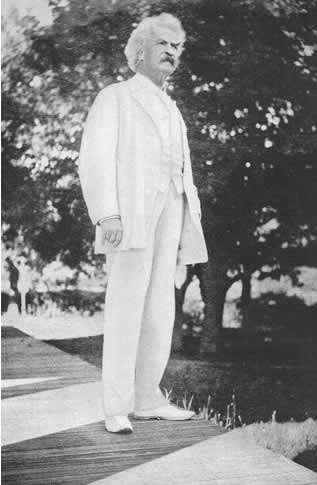
First publications
Christian Science with Notes Containing Corrections to Date is the final volume of the uniform editions of Mark Twain's works which were published in his lifetime. The book, written between 1898-1903, is a series of articles examining the Christian Science religion and its founder Mary Baker Eddy. Scholar Hamlin Hill best described the book as a mixture of "high satire and low burlesque." The 63,000-word volume consists of previously published magazine articles as well as new material. The book is divided into two "books." Book One consists of 9 chapters. Book Two consists of 15 chapters. There are also six appendixes, an additional essay titled "Mrs. Eddy in Error," and a conclusion.
In October 1899 Cosmopolitan magazine published "Christian Science and the Book of Mrs. Eddy" which became the first four chapters of Book One. In 1900 when Harper and Brothers were compiling the collection of stories titled The Man That Corrupted Hadleyburg and Other Stories they had the opportunity to include the Cosmopolitan Christian Science material plus four additional chapters of new material. Harper declined to include the material in the American edition of The Man That Corrupted Hadleyburg. However, Chatto and Windus included Book One with 8 chapters in the British edition of The Man That Corrupted Hadleyburg as did Clemens's German publisher Bernard Tauchnitz.
In the summer of 1902 Clemens returned to his manuscript and wrote Chapter 9 for Book One. He began publishing segments of the manuscript in the North American Review in December 1902, January 1903, February 1903, as well as an additional item in the April 1903 issue. The North American Review series brought reader feedback which pointed out errors in fact. Clemens collected reader responses to be used as notes for corrections that would be added to any book publication of the manuscript. The March 21, 1903 issue of Publishers' Weekly announced Harper and Brothers would be issuing a trade edition of Christian Science in the Spring. However, in a quick about face, Publishers' Weekly announced on April 11 that Harpers would not be publishing Mark Twain's papers on Christian Science and that orders for the book would be cancelled. Clemens wrote to one of his correspondents that Harper and Brothers had backed down because they were afraid to offend Christian Scientists:
The Harpers considered the publication inexpedient, as it might injure the house with the Christian Scientists.... The situation is not barren of humor: I had been doing my very best to show in print that the Xn Scientist cult was become a power in the land -- well, here was proof: it had scared the biggest publisher in the Union! (Hill, God's Fool, pp. 53-4.)
Harper waited until February 1907 to issue Christian Science with Notes Containing Corrections to Date. It was a time when Mary Baker Eddy and her followers had fallen out of favor in various newspapers and periodicals. The section identified as Book Two had never been previously published and was critical of Mary Baker Eddy herself. Harper issued the book in their uniform trade edition of red cloth and gold cornstalks as well as Volume 25 of the various uniform editions that had been initiated in 1899.
Refining the Work
The book publication of Christian Science with Notes Containing Corrections to Date, originally planned for 1903 but delayed until 1907, offered Clemens a chance to revise and refine the earlier magazine publications of his work. The most extensive study of the refinements Clemens made in his manuscripts was done by the editors of the Mark Twain Papers and published in the 1973 edition of What Is Man? And Other Philosophical Writings. The Works of Mark Twain edition edited by Paul Baender (University of California Press, 1973).
Accommodation Statement
In order to accommodate the purchasers of American Publishing Company's uniform editions which were issued from 1899-1903, Harper and Brothers bound Volume 25 to match the previous bindings of the earlier Autograph Edition, Edition De Luxe, Japan Edition, Author's De Luxe Edition, Royal Edition, Underwood, Riverdale, and Hillcrest editions. Each volume for previous American Publishing Company customers contained the following statement on the back of the title page:
This edition is printed by Harper & Brothers, the exclusive publishers of Mark Twain's works, as an accommodation to purchasers of earlier volumes with a view to making their sets uniform.
W. H. W. Bicknell's Contributions
 William Harry Warren Bicknell photo courtesy of the Winchester, Massachusetts Archival Center |
Frank Bliss hired new illustrators for American Publishing Company's uniform editions begun in 1899. Artist and etcher William Harry Warren Bicknell (b. 1860 - d. 1947) was born in Boston, Massachusetts, the son of a grocer. Bicknell graduated from the Boston Latin School in 1878 and later studied at the Boston Museum of Fine Arts. He was a pupil of Otto Grundmann and Frederic Crowningshield. Bicknell's etching of the Tiffany monogram appears as a title page in every volume of the Autograph Edition, Edition De Luxe, Japan Edition, Author's De Luxe Edition, and the Royal Edition. Bicknell's engraved title page is present in Volume 25 of these editions but it is omitted from the illustration list. Thus, Bicknell's work is uncredited in Volume 25 for these editions. Less expensive editions such as Underwood, Riverdale, and Hillcrest feature the Tiffany title page in Volume 1 only. It was eliminated altogether from the Author's National Edition. |

|
The frontispiece for all editions of Volume 25, Christian Science with Notes Containing Corrections to Date, is a photo of Clemens taken in 1906. |
Illustrations
Volume 25, Christian Science with Notes Containing Corrections to Date, contains no illustrations. Instead, Harper and Brothers chose to use two photographs of Christian Scientist churches -- one in Boston and the other in New York. As such, it is the least visually entertaining of all the 25 volumes included in the first uniform editions of Mark Twain's works. However, a manuscript written by Clemens, but not included in the book, indicates he planned to provide nine of his own illustrations but Harper refused to use them. In a manuscript titled "Concerning the Works of Art in this Book" he wrote regarding his publisher:
This one says the pictures will inflame the reader.
There is nothing in that argument. If a reader is so combustible, let him take out a fire policy. But there is no fear; it is not going to happen. When a reader understands a picture it does not inflame him. Very well, he will understand these pictures, because I shall explain them as I go along (Twain, p. 518).
His most inflammatory illustration was one that featured Christian Science founder Mary Baker Eddy with a crown on her head holding aloft a book titled Science and Health in her right hand and a one dollar coin held high in her left. Climbing up from the ground on a ladder to her waistline is a tiny figure that Clemens labeled "Dowie" after controversial faith healer John Alexander Dowie. Evidently, Harper won the battle of the illustrations because none by Mark Twain were used in an assault on Mary Baker Eddy and the Christians Scientists.
Illustration List for Volume 25
The End of One Line
Christian Science with Notes Containing Corrections to Date, Volume 25, was the final volume issued for the uniform editions begun by Frank Bliss and American Publishing Company in 1899 and continued by Harper and Brothers. Harper continued to publish the Author's National Edition in 25 volumes until 1920 selling it via newspaper and magazine coupons. This subscription edition was eventually taken over by the publishing house of P. F. Collier and Son.
_____
References
Blanck, Jacob, compiler. Bibliography of American Literature, Volume Two. (Yale University Press, 1957).
Hill, Hamlin. "Afterword." Mark Twain, Christian Science. (Oxford University Press, 1996).
_____. God's Fool. (Harper and Row, 1973).
Johnson, Merle. A Bibliography of the Works of Mark Twain. (Harper and Brothers, 1935).
Leary, Lewis, ed. Mark Twain's Correspondence with Henry Huttleston Rogers 1893-1909. (University of California Press, 1969).
Rasmussen, R. Kent. Critical Companion to Mark Twain, Volumes I and II. (Facts on File, 2007).
Twain, Mark. What Is Man? And Other Philosophical Writings. The Works of Mark Twain edition. Paul Baender, ed. (University of California Press, 1973).